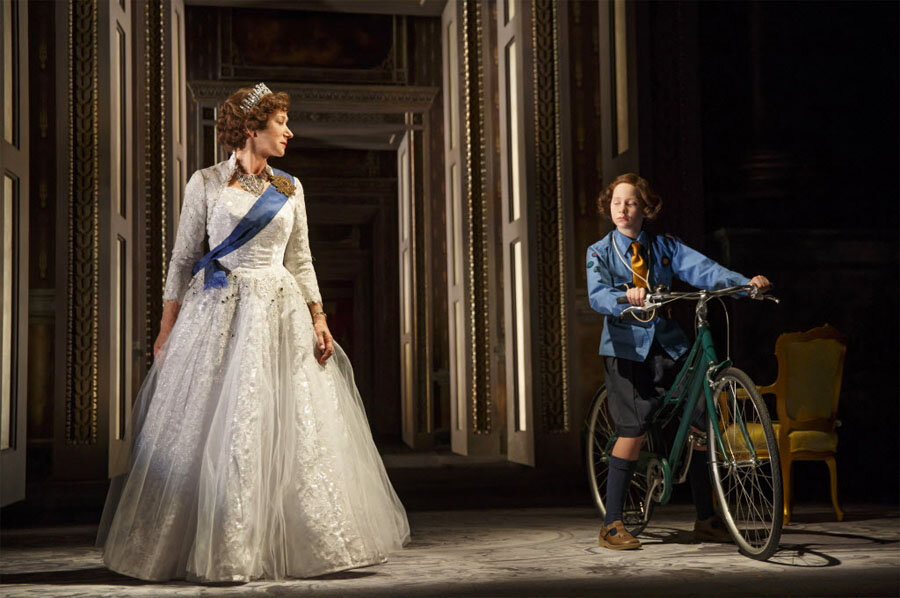Helen Mirren is astonishing as Queen Elizabeth II in 'The Audience'
Loading...
Every week, whenever possible, two of the most important people on the planet chat for about 20 minutes. It is a meeting held in complete secret.
The conversations between the United Kingdom's monarch and the prime minister take place in a room in Buckingham Palace with no one else present and no official records taken.
What do they talk about? How do they act? We may never know, and that's where playwright Peter Morgan enters with his "Audience," a moving and very human play about the costs of power.
The British import opened March 8 at the Gerald Schoenfeld Theatre with unarguably its most important ingredient intact: Helen Mirren as Queen Elizabeth II.
Mirren, who is becoming something of an expert on playing English royalty, creates an astonishing portrayal, by turns prickly and chummy, regal and regular, insecure and temperamental. She nails the fussiness and strange high-pitched voice but also reveals a frustrated yet resigned monarch quietly pining for a different life. Her quick changes often happen onstage with a new outfit and wig.
The Broadway version of the play has some actors from its West End run, but many are American, including Judith Ivey as Margaret Thatcher with an intimidating helmet of hair and Dylan Baker as an insecure John Major. Thankfully, Geoffrey Beevers as the queen's right-hand man is back at his fussy, imperial best.
The playwright has changed a few things, including tweaking the David Cameron meeting and adding a whole new Tony Blair chat that makes the play even more cohesive, making explicit the echoes between the 1956 Suez Crisis and the Iraq War.
The play plays with time as Morgan jumps back and forth over six decades to highlight meetings with eight prime ministers, with Mirren switching from age 25 with Churchill (a superb Dakin Matthews) to today's PM, David Cameron (Rufus Wright, who also plays Blair).
The more things change, the more they stay the same for this queen. "I suppose that's what happens if you stick round long enough. The same people, the same ideas come round again and again. Wearing a different colored tie," the queen quips.
Elizabeth II plays analyst and confessor to them all, listening to their dirty laundry and various illnesses, all the while joking about herself as "a tribal leader in an exotic costume" or "a postage stamp with a pulse."
The portrait of the queen that emerges is a thrifty woman, an ardent pacifist, and even perhaps a closet leftie. She seems happiest romping with her dogs in Scotland and the best scene is set there, with both her and prime minister Harold Wilson (a winning Richard McCabe), and her trading barbs. (He teases her about her German roots).
Morgan also charts time with the clever use of telephones. Keep an eye out as telegrams and then landlines evolve into the use of a mobile phone the size of a brick (in the Thatcher era) to a snazzy new modern-day Samsung with the maddening ringtone of "Thrift Shop."
The queen is haunted by her 11-year-old self who has never liked the drudgery of Buckingham Palace, and the play at these times threatens to move into melodrama, but director Stephen Daldry makes the will-be-queen and the established queen – who you may notice both rock on their toes – work well in the same scene. A pair of real Corgis sprinting across the stage will also draw oohs and ahhs.
Designer Bob Crowley, known for his big works like "Aladdin" and "Mary Poppins," shows off his more minimal – yet no less luxurious side – here, with a pair of elegant yellow armchairs and a backdrop of pillars and never-ending rooms. He also takes on the costumes, which range from a stunning, jewel-studded gown to bespoke three-piece suits.
But perhaps the best stitching is from Morgan, who nimbly fits in exposition and big swaths of history into a coherent and touching portrait of power and majesty. And, with Mirren, even ardent anti-monarchists will clap.







